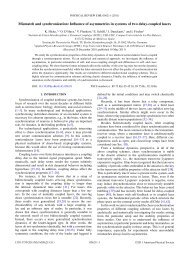DBI Analysis of Open String Bound States on Non-compact D-branes
DBI Analysis of Open String Bound States on Non-compact D-branes
DBI Analysis of Open String Bound States on Non-compact D-branes
Create successful ePaper yourself
Turn your PDF publications into a flip-book with our unique Google optimized e-Paper software.
CHAPTER 3. SUPERSTRINGS 49F, when acting <strong>on</strong> a NS state, returns the number <str<strong>on</strong>g>of</str<strong>on</strong>g> times a fermi<strong>on</strong>ic operator hasbeen acted <strong>on</strong> the groundstate in order to obtain this state. So we see thatG|0〉 = −1, (3.49)and that acting <strong>on</strong> other states, G will be 1 for half-integer mass levels (levels, notmasses!) and -1 for integer mass levels. The GSO projecti<strong>on</strong> for the NS sector c<strong>on</strong>sistsin keeping <strong>on</strong>ly those states with positive G-parity. This way, we eliminate the tachy<strong>on</strong>from the spectrum, as well as all other states with half-integer mass, which was exactlywhat we wanted.For the R sector, G becomes a generalized chirality operator,∞∑G = Γ 11 (−1) F with F = d i −rd i r, (3.50)with Γ 11 the ten-dimensi<strong>on</strong>al chirality operator. The GSO projecti<strong>on</strong> in the R sectorc<strong>on</strong>sists <str<strong>on</strong>g>of</str<strong>on</strong>g> keeping <strong>on</strong>ly <strong>on</strong>e <str<strong>on</strong>g>of</str<strong>on</strong>g> both chiralities. Which <strong>on</strong>e is purely a matter <str<strong>on</strong>g>of</str<strong>on</strong>g> choice.This effectively eliminates half <str<strong>on</strong>g>of</str<strong>on</strong>g> all states at every mass level.Since the result is too beautiful not to menti<strong>on</strong>, we will take a quick look at themodified generating functi<strong>on</strong>s for the truncated (i.e. what is left after performing theGSO projecti<strong>on</strong>) spectra. To update f R (x) (Eq. 3.46), it suffices to change the factorin fr<strong>on</strong>t <str<strong>on</strong>g>of</str<strong>on</strong>g> the product from 16 to 8:+∞ ∏f R (x) −→ fR GSO (x) = 8n=1n=1( 1 + xn1 − x n ) 8. (3.51)In the NS sector, we need to subtract all states obtained by acting with an even number<str<strong>on</strong>g>of</str<strong>on</strong>g> raising b operators from the full spectrum. This can be achieved by c<strong>on</strong>sidering thegenerating functi<strong>on</strong>1+∞ ∏√ xn=1(1 − x n−1 21 − x n ) 8= 1x −1 2 − 8x 0 + 36x 1 2 − 128x 1 + . . . , (3.52)in which we see that states corresp<strong>on</strong>ding to an odd number <str<strong>on</strong>g>of</str<strong>on</strong>g> b operators carry a − sign,while states corresp<strong>on</strong>ding to an even number <str<strong>on</strong>g>of</str<strong>on</strong>g> b operators carry a + sign. Howeverwe see that when we subtract Eq. 3.52 from the unc<strong>on</strong>strained spectrum generated byEq. 3.41, we will double the number <str<strong>on</strong>g>of</str<strong>on</strong>g> states that survive, so we need to divide by anadditi<strong>on</strong>al factor <str<strong>on</strong>g>of</str<strong>on</strong>g> two to rectify this. C<strong>on</strong>cretely, our new generating functi<strong>on</strong> becomesf NS (x) −→ f GSONS (x) = 12 √ x⎡∞∏⎣n=1(1 + x n−1 21 − x n ) 8−∞∏n=1( ) ⎤ 81 − x n−1 2⎦.1 − x n (3.53)At first sight, this looks like bad news, but incredibly enough, it was proven by CarlGustav Jacobi in 1829 (!) that indeed,⎡ ( ) 8 ( ) ⎤ 81∞∏2 √ ⎣1 + x n−1 2∞∏ 1 − x n−1 2∞∏( )x 1 − x n −⎦ 1 + xn 81 − x n = 81 − x n , (3.54)n=1n=1n=1
















